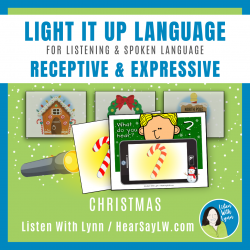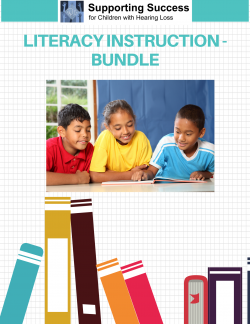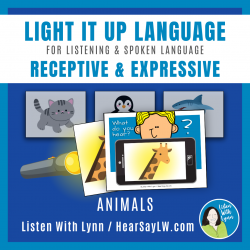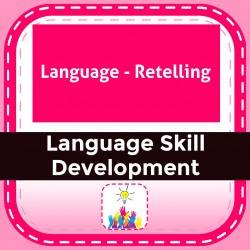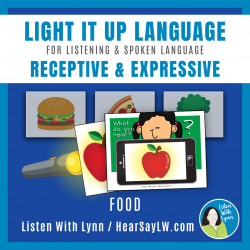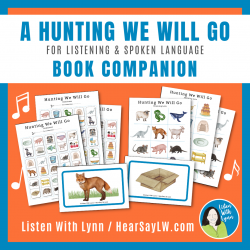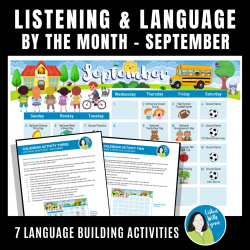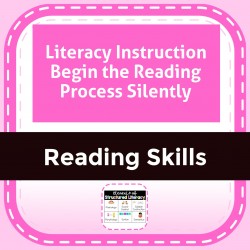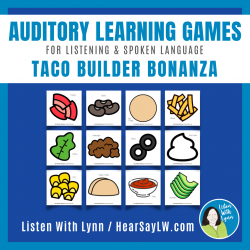Ability Levels
Categories
Resource Types
Age/Grade Range
CCSS
Anchor Standard
Speaking & Listening
Language
Reading
CHRISTMAS Auditory Processing Receptive & Expressive Language Game
$ 5
You'll love the Christmas version of Light It Up Language! Kids listen to clues to identify 16 hidden holiday vocabulary pictures. This engaging activity targets auditory memory, comprehension, proces
...
essing, and receptive and expressive language skills.The magic happens by lighting up the “What Do You Hear?” cards. Hidden pictures are held up to a flashlight and the Christmas images amazingly appear. How fun!TARGETS: RECEPTIVE: This game builds critical thinking and reasoning skills by categorizing, making inferences, and drawing conclusions. EXPRESSIVE: Once the hidden picture is revealed the child recalls and uses the clues to describe the object. Thereby, stretching their auditory memory, descriptive language, and expressive language skills.INCLUDES:✧ Listening & language guide with instructions✧ Target or goal suggestions✧ 8 What Do You Hear? cards (printed twice)✧ 16 Christmas Hidden Object Picture Vocabulary Cards✧ 64 Prompt Clues - 16 objects with four details each that get increasingly more specific✧ A Script with scaffolding strategies✧ Listening and Spoken Language TipsEASY one-time quick game prep and you're all set year after year.You’ll need a flashlight, a lamp, or a sunny window.◈ ◈ ◈ ◈ ◈ ◈ ◈ ◈ ◈ ◈ ◈ ◈ ◈ ◈ ◈ ◈ ◈ ◈ ◈ ◈ ◈ ◈ ◈ ◈ ◈ ◈ ◈ ◈ ◈ CUSTOMER TIPS:➼ Questions? Email me before purchasing this resource or anytime later.♥ Sign-up HERE for the Listen With Lynn emails♥ For more ideas visit my blog: HearSayLW.comSTAY CONNECTED:✧ Sign-up here for the Listen With Lynn emails✧ Follow onFacebook - Lynn A. Wood - LSL Auditory Verbal Therapist and Rehab Audiologist✧ Follow on Instagram @auditoryverbal_listenwithlynn❤ Keep up your excellent work. I am blessed to help along the way. Thanks so much!Lynn Wood
Literacy Instruction - BUNDLE
$ 795
This bundle includes instructional strategies for literacy instruction beginning with print awareness to reading comprehension. The 5 components of literacy are discussed in detail, and activities ar
...
e included, many for all levels of instruction. 48 pages. Includes ID numbers: 0971, 0972, 0980, 0982, 0983, 0985, 0986, 0987, 0988.
ANIMALS Auditory Processing Receptive & Expressive Language
$ 5
You'll love the ANIMALS version of Light It Up Language! Kids listen to clues presented through hearing alone to identify 16 hidden ANIMALS vocabulary pictures. Each of the pictures has four clues th
...
ues that are increasingly more specific.The magic happens by lighting up the “What Do You Hear?” cards. Hidden pictures are held up to a flashlight and the ANIMALS images amazingly appear. How fun! Once the hidden picture is revealed the child recalls and uses the clues to describe the ANIMALS. Thereby stretching their auditory memory, descriptive language, and expressive language skills.TARGETS: RECEPTIVE: This game builds critical thinking and reasoning skills by categorizing, making inferences, and drawing conclusions. EXPRESSIVE: The child recalls and uses clues to describe the hidden object. INCLUDES:✧ Listening & language guide with instructions✧ Target or goal suggestions✧ 8 What Do You Hear? cards (printed twice)✧ 16 Hidden ANIMALS Picture Vocabulary Cards✧ 64 Prompt Clues - 16 objects with four details each that get increasingly more specific✧ A Script with scaffolding strategies✧ Listening and Spoken Language Tips ➼ EASY one-time quick game prep and you're all set to use year after year. ➼ You’ll need a FLASHLIGHT, a lamp, or a sunny window.◈ ◈ ◈ ◈ ◈ ◈ ◈ ◈ ◈ ◈ ◈ ◈ ◈ ◈ ◈ ◈ ◈ ◈ ◈ ◈ ◈ CUSTOMER TIPS:➼ Questions? Please email me before purchasing this resource or anytime later.♥ Sign-up HERE for the Listen With Lynn emails♥ For more ideas visit my blog: HearSayLW.comSTAY CONNECTED:✧ Sign-up here for the Listen With Lynn emails✧ Follow on Facebook - Lynn A. Wood - LSL Auditory Verbal Therapist and Rehab Audiologist✧ Follow on Instagram @auditoryverbal_listenwithlynn❤ Keep up your excellent work. I am blessed to help along the way. Thanks so much!Lynn Wood
Language - Retelling
$ 295
Explanation to parents and teachers about the importance of retelling and sequencing events. Worksheets include: sequencing stages of a butterfly, retelling events of the school day, finding the begin
...
ning, middle and ending of a story, fiction and non-fiction reader response forms.
FOOD Auditory Processing Receptive & Expressive Language
$ 5
You'll love the FOOD version of Light It Up Language! Kids listen to clues to identify 16 hidden FOOD vocabulary pictures. Each of the pictures has four clues that are increasingly more specific.The m
...
magic happens by lighting up the “What Do You Hear?” cards. Hidden pictures are held up to a flashlight and the FOOD images amazingly appear. How fun! Once the hidden picture is revealed the child recalls and uses the clues to describe the FOOD. Thereby stretching their auditory memory, descriptive language, and expressive language skills.TARGETS: RECEPTIVE: This game builds critical thinking and reasoning skills by categorizing, making inferences, and drawing conclusions. EXPRESSIVE: The child recalls and uses clues to describe the hidden object. INCLUDES:✧ Listening & language guide with instructions✧ Target or goal suggestions✧ 8 What Do You Hear? cards (printed twice)✧ 16 Hidden FOOD Picture Vocabulary Cards✧ 64 Prompt Clues - 16 objects with four details each that get increasingly more specific✧ A Script with scaffolding strategies✧ Listening and Spoken Language Tips ➼ EASY one-time quick game prep and you're all set to use year after year. ➼ You’ll need a FLASHLIGHT, a lamp, or a sunny window.◈ ◈ ◈ ◈ ◈ ◈ ◈ ◈ ◈ ◈ ◈ ◈ ◈ ◈ ◈ ◈ ◈ ◈ ◈ ◈ ◈ CUSTOMER TIPS:➼ Questions? Please email me before purchasing this resource or anytime later.♥ Sign-up HERE for the Listen With Lynn emails♥ For more ideas visit my blog: HearSayLW.comSTAY CONNECTED:✧ Sign-up here for the Listen With Lynn emails✧ Follow on Facebook - Lynn A. Wood - LSL Auditory Verbal Therapist and Rehab Audiologist✧ Follow on Instagram @auditoryverbal_listenwithlynn❤ Keep up your excellent work. I am blessed to help along the way. Thanks so much!Lynn Wood
A HUNTING WE WILL GO Listening, Language, & Literacy Book Companion
$ 6
Oh, A-Hunting We Will Go is my favorite rhyming story and song for growing listening, language, and literacy with preschoolers and early elementary-aged children. I have included it for years as part
...
part of my Thanksgiving thematic unit. The playfulness of the song with the repetitive verses and humorous well-loved warm illustrations can help children develop early spoken language and literacy skills, such as auditory discrimination, phonological awareness, vocabulary development, and auditory memory.This companion gives you a variety of hands-on games for children with hearing loss and those with typical hearing to practice listening for, recognizing, and producing rhymes. I love helping therapists and teachers instill a love of shared book-reading that has kids engaged and excited.This book companion was created to be used with the popular folk song, Oh, A-Hunting We Will Go by John Langstaff and illustrated by Nancy Winslow Parker. The activities correspond with the style of the book's illustrations.Three Games* for listening for, recognizing, and producing rhymes.1. Go Turkey - (24) playing cards2. Rhyming Lotto - (8) Lotto cards3. Rhyming Dominos - (45) dominos*The games are not visual matching games rather players ask for rhyming pairs. (Example: I have a snake. Do you have a card that rhymes with snake?)WHAT'S INCLUDED:Listening and Language Guide3 Games with charming graphics5 Happy Hunting extension activitiesListening & Spoken Language (LSL) TipsEASY ONE-TIME PREPPrint and cut out the games and Lotto boards. Done.PLEASE NOTE: A physical copy of the book Oh, A-Hunting We Will Go by John Langstaff and illustrated by Nancy Winslow Parker is not included in the digital download. The public library or Amazon, Thriftbooks, eBay are great places to look for a copy.◈ ◈ ◈ ◈ ◈ ◈ ◈ ◈ ◈ ◈ ◈ ◈ ◈ ◈ ◈ ◈ ◈ ◈ ◈ ◈ ◈ ◈ ◈ ◈ ◈ ◈ ◈ ◈ ◈ ◈ ◈ ◈ ◈ ◈LET'S CONNECT:★ Sign up HERE for the Listen With Lynn emailsInstagramFacebookKeep up your good work. I am blessed to help along the way.Thanks so much!Lynn Wood
SEPTEMBER LISTENING VOCABULARY COMPREHENSION
$ 5
The SEPTEMBER Listening and Language By The Month resource includes seven activities that can be used ALL MONTH for auditory memory and comprehension, seasonal vocabulary, developing grammar, and buil
...
Literacy Instruction Begin the Reading Process Silently
$ 2
These instructional strategies for developing students' silent reading skills including making connections, asking questions, visualizing, determining text importance, inferencing, and synthesizing.
TACO BUILDER BONANZA 5 Ways to Play Game Listening, Language
$ 5
Taco Builder Bonanza is a fun, flexible, and engaging listening and spoken language resource. Players listen, play, and talk while building tacos. It can be played again and again with many kids and g
...
oals across your whole caseload. It's easy for you with a one-time prep. ➼ Children have a blast and don’t realize they are following and giving directions, learning spatial and temporal concepts, vocabulary, auditory memory, comprehension, and sequencing skills. Sandwich Scramble grows social skills and kids learn turn-taking, problem-solving, and self-advocacy while role-playing. ➼ Taco Builder Bonanza is a flexible resource. Play using all the cards, sort out a smaller set, or simplify the directions. It is easy to level up or down the directions to meet a child’s needs and goals.
ONE PRODUCT - FIVE GAMES OR WAYS TO PLAYTACO BONANZA targets auditory goals that relate to the following directions: ✧ GAME 1: Highlights temporal concepts and sequencing.
✧ GAME 2: Targets critical elements and complex directions.
✧ GAME 3: Focuses on spatial relationships.
✧ GAME 4: Role-playing turn-taking, problem-solving skills social, pragmatic,
and self-advocacy skills.
✧ GAME 5: Auditory comprehension and listening for detail INCLUDES:
➼ A guide with instructions ➼ 12 Large colorful mix-and-match taco ingredients and a digital PDF for screen sharing ➼ 5 games with examples ➼ Lesson expansion ideas with read-aloud story suggestions ➼ Listening and spoken language (LSL) Tips FACE TO FACE AND TELETHERAPY ✢PRINT - One-time easy prep and use time and time again
✢ DIGITAL - The digital page can be opened and played with your favorite PDF reader app on a tablet or iPad. - Tokens can be placed directly on the screen - On a computer open the PDF with the taco ingredients and use a PDF reader such as Adobe Acrobat Reader DC which is free. - The listener can use the annotation tools to mark the card. ◈ ◈ ◈ ◈ ◈ ◈ ◈ ◈ ◈ ◈ ◈ ◈ ◈ ◈ ◈ ◈ ◈ ◈ ◈ ◈ ◈ ◈ ◈ ◈ ◈ ◈ ◈ ◈ ◈ ◈ CUSTOMER TIPS:
➼ Questions? Email me before purchasing this resource or anytime later♥ Sign up HERE for the Listen With Lynn EmailsLet’s Connect:
Instagram
Facebook
Keep up your good work. I am blessed to help along the way. Thanks so much!
Lynn
Cook With Me Listening and Language Fall and Thanksgiving
$ 5
8 Fall-themed recipes with minimal ingredients and steps provide authentic opportunities for children to listen, follow directions, and develop self-help skills. Preparing food, cooking, and cleaning
...
ng up expands vocabulary and introduces new concepts while encouraging thinking, problem-solving, and promoting literacy skills. Cooking together invites natural communication and conversational skills.Ideal for: Speech, Listening and Spoken Language, Auditory Verbal sessions, or lessons at school. Face to Face Lessons. Mixed groups. Parent-guided teletherapy. Send for home activities.Includes:★ 8 Recipes with Minimal Ingredients and Steps★ 6 Edible and 2 Craft Recipes★ Recall and Retell Sheet★ Listen and Learn Recipe Cookbook Cover★ Handout with Two Pages of Targets for Listening and Language Opportunities★ Encourages Thinking, Problem-Solving, and Promotes Literacy Skills★ Listening and Spoken Language (LSL) TipsEight Beautifully Designed Recipe CardsTurkey CookiesFruit CornucopiasTurkey QuesadillaChocolate AcornsPumpkin Pie in a CupPumpkin Snack MixPumpkin Cheesecake DipPumpkin Playdough (non-edible)Teletherapy, Distance Learning & Face to Face✢ Print✢ Digital to share on an iPad or computer screen◈ ◈ ◈ ◈ ◈ ◈ ◈ ◈ ◈ ◈ ◈ ◈ ◈ ◈ ◈ ◈ ◈ ◈ ◈ ◈ ◈ ◈ ◈ ◈ ◈ ◈ ◈ ◈ ◈ ◈CUSTOMER TIPS:➼ Questions? Email me before purchasing this resource or anytime later♥ Sign-up HERE for the Listen With Lynn Emails♥ Let’s Connect:InstagramFacebookKeep up your good work. I am blessed to help along the way. Thanks so much!Lynn
 Your browser is out of date. For best experience switch to latest updated Browser.
Your browser is out of date. For best experience switch to latest updated Browser.
 Get Chrome
Get Chrome Get Edge
Get Edge Get Firefox
Get Firefox